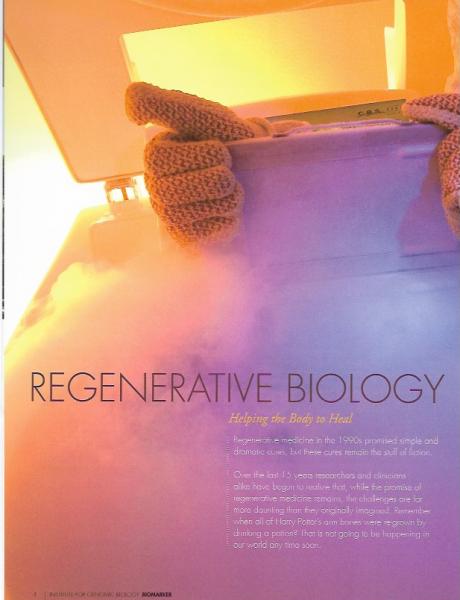Helping the Body to Heal
Institute for Genomic Biology, University of Illinois
Regenerative medicine in the 1990s promised simple and dramatic cures, but these cures remain the stuff of fiction.
Over the last 15 years researchers and clinicians alike have begun to realize that, while the promise of regenerative medicine remains, the challenges are far more daunting than they originally imagined. Remember when all of Harry Potter’s arm bones were re-grown by drinking a potion? That is not going to be happening in our world any time soon.
“The huge promise of tissue engineering in the ’90s had people thinking we were going to have livers, kidneys, hearts, whole replacement organs we could grow. It set up impossible targets to actually hit,” says Brendan Harley, professor of chemical and biomolecular engineering and a member of the IGB Regenerative Biology and Tissue Engineering theme (ReBTE).
Having said that, researchers in the ReBTE theme are surging forward on various fronts in their efforts to make tissue engineering a reality. The theme brings together scientists in nanotechnology, bioengineering, cell biology, genomics, biomaterials, and computer sciences, as well as linking with clinical programs at both Carle Hospital and the School of Medicine. These researchers are looking both at creating material that has direct clinical applications and using biomaterials and engineering approaches to understand the basic science behind regenerative medicine.
Some of the research questions being investigated include:
· How can micro- and nano-environments be created to optimize tissue development and engineering?
· How can new therapies for chronic conditions or tissue and organ replacement be developed from understanding healthy tissue regeneration?
· How can design rules for simple cell-based systems and devices be applied to more complex biological systems and devices?
· How can cost-effective clinical treatments be derived from the manipulation of stem cells to treat chronic conditions?
In most cases tissue regeneration work involves creating a kind of scaffold, either of a hard material mimicking bone, or a soft material, in the case of hydrogels. In both cases the scaffold enables and, ideally, encourages the body to re-grow tissues along that framework, eventually degrading it and replacing it with new tissue.
Harley, for example, is working on developing a material to repair damaged tendon, whether the damage occurs in the middle of the tendon or where the tendon attaches to bone, as is the case in a torn rotator cuff. Tendons in the shoulder and elsewhere suffer a lot of both acute and chronic damage. Harley’s group is trying to create materials and approaches for both kinds of damages, while also keeping in mind regulatory and intellectual property aspects of the project “before we get very far along, in order to shorten translation to commercial applications,” he says.
In some cases, rotator cuff surgery currently has a failure rate of 90%. Harley says this is because in essence, the tendon is getting reattached back to bone, without addressing the needs specific to such a heterogeneous site.
In order to help improve these kinds of surgeries, Harley’s group is looking to understand tendon material, the bone and the interface between the tendon and the bone. This project builds on what Harley did before coming to the University of Illinois, in which he and a fellow graduate student developed a material that mimics the interface between cartilage and bone. Although there are several differences, that experience helped Harley as he set out to learn about tendons and tendon injuries.
By themselves, tendons have a complex and heterogeneous microstructure. In the proper environment, which also is heterogeneous, they grow structures of aligned collagen material, which is perfectly suited to their function. Ina more uniform environment, however, tendons don’t grow that way. Harley would like to understand what factors in the environment are most crucial to proper growth patterns and how to create those factors at the wound site. In addition, he is working to understand the tendon and bone interface in the hopes of helping the body re-grow that region as well, much as he did with the cartilage project.
Matt Wheeler, another member of the ReBTE theme, also is working to repair damaged bone, but he is focused on helping soldiers who have sustained extensive injuries, particularly craniofacial ones. Wheeler’s lab is approaching the project from the stem cell direction. Like stem cells, fat cells can be programmed to make bone, cartilage, muscle, fat and connective tissues. Wheeler has been building a biodegradable scaffold of polymers that fit precisely into the damaged region. The scaffold is seeded with fat cells, which, in the proper environment, will grow into bone cells. Alternatively, the scaffold can be seeded with molecular instructions that will tell the body’s own fat cells to migrate to the wound site and begin to make bone.
“So if you have an injury anywhere in the body, and if it’s the right kind of injury, these cells can be mobilized,” says Wheeler.
Wheeler, Harley and other colleagues are looking for ways to encourage more rapid bone growth in the hopes that any patient with craniofacial injuries would not have to endure 50-60 surgeries to repair bone damage. Of course there is a catch: researchers need to figure out how to not only signal the bone to grow but also to turn off that signal.
“You want to regenerate tissue but then you want it to stop,” notes Wheeler. “The question is whether the body’s natural signal to stop will work so you don’t end up with a two-foot-long jaw.”
In other cases within the theme, researchers are trying to create a biomimetic environment to support soft tissue repair. Hyun Joon Kong, for example, is working to promote re-vascularization, an important process in repairing both bone and soft tissue injuries. He is developing hydrogels, which are formed from the cross-linking of water-soluble polymers, that serve as a “nano- or microporous scaffold,” and mimic — and further improve — the physical properties and permeability of the provisional matrix naturally formed at the injury.
“We are interested in designing and characterizing hydrogels and determining how cells interact with those hydrogels so together they can ultimately develop a nicely interconnected vascular system,” says Kong, also a faculty member in chemical and biomolecular engineering. His approach has been to create a provisional matrix, “a kind of factory to stimulate cells to make new tissue.”
Varying the percentage of each ingredient within a hydrogel gives different results. Different recipes result in differing mechanical properties like stiffness, toughness and degradability, as well as differing abilities to deliver chemical cues and perform other transport functions. These properties influence how well cells will function in the hydrogel. That, ultimately, is the challenge: to make hydrogels sturdy and yet hospitable to regenerative cells.
Joon’s other goal is to move his hydrogel from in vitro to in vivo, which embodies another set of challenges, such as delivering the hydrogel to the proper location, making sure it stays there, designing the hydrogel so it is not attacked by the body and encouraging the cells to make new vascular networks.
A big requirement for much of tissue regeneration work, and one Harley is particularly cognizant of, is to develop useful tools that can be applied to a clinical product as quickly as possible. The material he developed that mimics the cartilage bone interface is currently being tested in clinical trials with 15 patients.
This experience helped Harley appreciate the steps involved with the regulatory and commercial side of his work and has already helped guide his work with tendon repair.
Some of the issues Harley and his colleagues keep in mind are:
· Designing material systems that can be quickly translated to clinical applications and get approved by the FDA in as short amount of time as possible.
· Figuring out how to scale up this product as quickly as possible.
· Designing the material so that is can be implanted easily and accurately by every surgeon.
Now that he is in academia, Harley says he also has the luxury to answer some broader questions, such as how to best design material for orthopedic uses, how do you get bone to grow more rapidly (hint: it involves changing calcium chemistry proportions and balancing porosity with strength). He would also like to better understand degradation kinetics and pore structure and behavior, all things that will impact biomaterials and tissue regeneration.
The goal within regenerative medicine as a whole has shifted from growing whole organs outside the body to inserting biomaterials that can stave off the need for massive intervention by preserving the function of the given organ. In order to develop biomaterials, however, researchers need to better understand disease progression and the disease state. That is because tissue regeneration is going to be far more difficult in a patient with a chronic injury or one with other illnesses than someone with an acute injury surrounded by otherwise healthy and vital tissue.
“You can’t re-grow cartilage of a 15-year-old in the knee of someone who is 80 and has had osteoarthritis for 20 years,” Harley points out.
Whether and when regenerative medicine will keep its promise is uncertain. But the researchers at IGB are doing their part to further that work.
“We ‘re may never be able to do ‘kazam’ or whatever they do in Star Trek and you’re all healed, but can we put in material to stave off massive intervention?” says Harley. “That’s one of the big goals, to preserve function and some normalcy.”



0 Comments